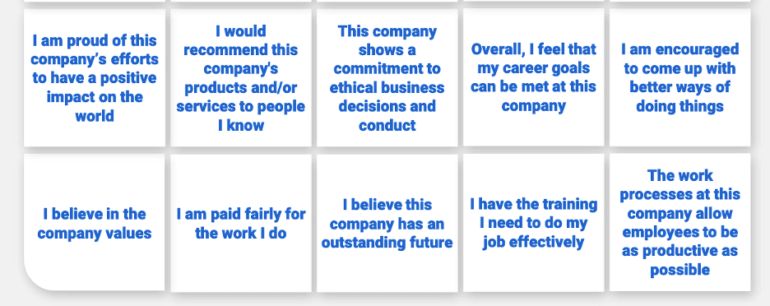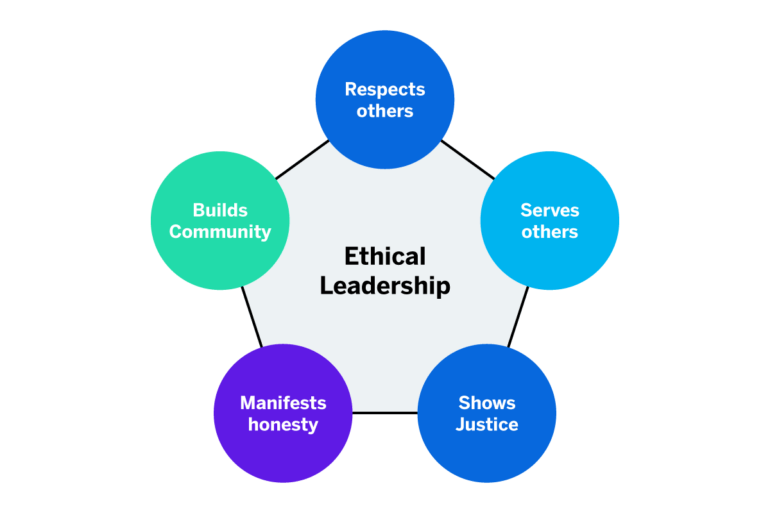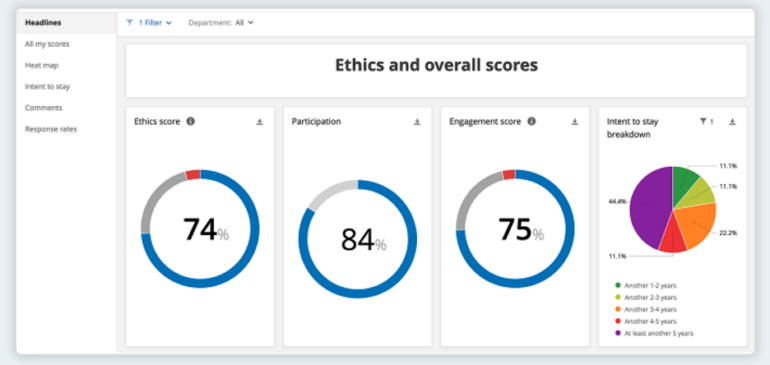Employee Experience
How to define and develop your workplace ethics
Ethics influence every part of your business. Here’s why ethics in the workplace matter, how to develop them and how to make sure your company excels at making ethical choices.
What are workplace ethics?
Ethics are a set of moral guidelines that an organization lives by. Just as families share a moral code, and parents instill moral values with their children, a company’s ethics set the moral compass for relationships with customers, between colleagues and in relation to the wider community.
“Leaders are in a position of power, and if they start to make unethical decisions it can quickly lead to a toxic workplace culture.”
Workplace ethics are relevant in every industry. Whatever line of business you’re in, ethics will come into play at some point – in big or small ways.
When it comes to employee experience, workplace ethics are linked to some of the most important drivers of positive outcomes, like trust in leadership, psychological safety and belonging, corporate social responsibility (CSR) and living the company values. Businesses that encourage ethical behavior and nurture an environment where ethical conduct is the norm are likely to see benefits in many other aspects of employee experience, including retaining and attracting talent.
How ethical is your workplace culture? Measure workplace ethics as part of your EX program
Why are ethics in the workplace important?
A company’s moral principles are an important component of its culture, its dealings with customers and suppliers, its brand and public image, and its relationship to its immediate community.
When it comes to employee experience, a company’s ethics can influence things positively or negatively. Sometimes it’s about working somewhere you feel proud of and aligned with. Sometimes it’s simply about feeling safe and valued in the workplace.
Aligned values, strong employer brand
Firstly, a company with strong ethical values and a commitment to corporate social responsibility will likely be somewhere employees feel proud to work. Feeling aligned with company values can help employees feel engaged at work and less likely to want to leave. This kind of ethical workplace is also likely to be more attractive to potential candidates, particularly those who want a meaningful career in an organization that shares their personal values.
A sense of respect and belonging
In ethical workplace cultures, employees are more than just economic units. People are more likely to feel fulfilled and engaged when working for businesses who take good care of their employees and value them both in and out of the workplace.
This aspect of ethics in the workplace came into sharp focus in the early stages of the COVID-19 pandemic. Companies who stepped up to contribute to their communities and look after their workers were seen in a positive light, whereas those that did not were seen as laggards. Great workplaces provided a sense of security and identity during a crisis. At the end of 2020, belonging emerged as the strongest driver of employee engagement in our global study.
Download the 2021 employee experience trends
Should you have a formal ethics program?
Implementing a formal ethics program has a huge positive impact, according to the US Ethics and Compliance Initiative. Research from their National Business Ethics Survey of US businesses found that companies with a program in place saw lower rates of misconduct, and a higher level of reporting when ethical violations did occur.
“A company’s ethics are defined and modeled by leadership, built and amplified through culture.”
In companies with a formal ethics program, 87% of employees who observed misconduct reported it, compared with 32% in businesses without a program.
In developing a program, businesses spend time thinking about their higher purpose and vision, clarifying their mission and core values. Without a defined ethical position, it’s very easy for a business to make decisions solely based on maximizing income and profit, and to lose sight of the longer-term qualities that will help it grow and endure.

Listed above are some of the most important employee experience signals relating to ethics and fairness
Common ethical moments that can arise in the workplace
Here are some examples of ethical dilemmas or gray areas that can happen in a work setting.
- An interviewer asking a job applicant if she has children. This can be construed as a discriminatory question. It’s not necessarily unethical, but it crosses legal and compliance boundaries for fair and equitable hiring practices.
- A supervisor failing to provide the necessary personal protective equipment (PPE) – such as safety gloves, hard hats, ear plugs, safety goggles etc – which ensures that staff can perform their jobs safely.
- An employee lying about their position to a prospective vendor, or making orders or decisions they’re not in a position to make.
- Taking office supplies from work for personal use.
- Giving a subordinate preferential treatment because they’re friends.
- Making personal purchases with a company credit card.
- Calling in sick when really, the employee wanted to spend the day at the beach.
- Setting very high targets for a less-able employee, knowing they will fail and you will be in a position to dismiss them.
- Fudging the numbers on a presentation in order to make the business look more profitable to investors.
- An HR leader knowing that different criteria are used to determine promotions in different offices, but not taking action.
How to encourage ethical behavior in your workplace culture
A company’s ethics are defined and modeled by leadership, built and amplified through culture.
The more ethics are practiced, the stronger they will grow, which is why it’s a good idea to make them visible and explicit throughout your business. Having them clearly displayed and amplified will help to keep them front-of-mind with all your employees at every level.
You could be doing this at new hire orientation, team meetings, town halls, and every day with your customers. Leadership example is also a powerful way to communicate ethics – employees will learn the appropriate behaviors by seeing leadership modeling them.
The power of ethical leadership
Leaders are in a position of power, and if they start to make unethical decisions it can quickly lead to a toxic workplace culture. In a hot-water situation, an employee might ask themselves ‘what is leadership expecting me to do in this moment?’ The kind of leadership behavior they have seen and noted elsewhere in the company will guide their decision.
Bribery
Ethical norms vary from region to region. For example, in some cultures, accepting bribes is a normal part of doing business. If a company from a culture where this isn’t the norm, such as the US, does business there, leadership must decide what the company’s stance will be. The question may first be raised by someone in sales, but eventually an individual with decision-making power will need to determine whether taking or offering bribes is in line with the company’s values.
Product safety
Another leadership-level ethical choice might be around a product recall. If a business producing children’s toys finds out there’s a quality issue with their product, they must weigh up the risk of a small number of dangerous products against the financial cost of doing a mass recall. A choice like this affects not only the business ethics and culture, but the wider community.
Whistleblowing
Finally, an important ethical arbiter is what happens when an employee brings an issue to light with leadership, through a formal process or otherwise. Does that person experience retaliation or retribution? Do they feel confident that the problem will be addressed, or is there a perception that they shouldn’t rock the boat?
Trust that leadership is ethical and clear about their moral stance has been linked with better performance in employees, according to recent research. Likewise, research suggests that unethical leadership is often a catalyst to misconduct lower down the hierarchy.

Examples of companies with strong ethical practices
- Technology hardware firm Fairphone has made sustainability and ethics the foundation of its brand. The company produces mobile phone handsets that are produced from materials that have been ethically sourced without unfairly exploiting either the people in the supply chain or the planetary resources required to manufacture tech. Their smartphones are modular and can be repaired and upgraded for a longer lifespan, keeping them out of landfill.
- US restaurant Chipotle acts ethically across its supply chain. The company sources meat from suppliers that don’t use artificial hormones or antibiotics in production, which shows a commitment to animals and to their customers. Chipotle also tries to prioritize local businesses, which supports the community.
- Hotel group Hilton uses its Hilton Effect Foundation to make connections with its local communities and support those in need, particularly people affected by the pandemic. Its 1 Million Rooms program offered free hotel stays around the USA for frontline workers.
- Industrial manufacturer 3M, originator of Scotch tape and the Post-it, has been named as one of the world’s most ethical companies. As of 2019, it requires every new product to have a Sustainability Value Commitment to show how it contributes to the greater good. 3M prioritizes its employee experience, offering a flexible work program that allows its people to design their own schedules, and a ‘15% Culture’ where employees are encouraged to spend 15% of their work time pursuing ideas that excite them personally.
What are some unethical behavior examples?
When it comes to illegal behavior in the workplace, there is a very clear line. Rules about physical harm, discrimination and harassment are often defined by law. For example in the United States, employers must comply with the safety laws enforced by the Occupational Safety and Health Administration and anti-discrimination laws enforced by the Equal Employment Opportunity Commission.
Rules around discrimination and harassment protect certain classes of people from unfair treatment on the basis of things like race, age, disability, gender or sexuality. When these rules are broken, it’s very clear how an organization should behave.
However, legal violations almost never come out of nowhere. There is typically a series of events leading up to the crossing of a legal line, where behaviors aren’t strictly illegal but are certainly unethical. By the time the legal tipping point is reached, it’s possible that unethical behavior will already have caused significant damage, whether in terms of employee morale, a company’s reputation or by depleting the company’s resources.
Unethical workplace behavior: bullying
One prime example of behavior that can escalate from unethical to illegal is bullying. Most people can relate to this, and almost everyone at least knows someone it has happened to. Bullying can happen between co-workers or it can be practiced by management against more junior staff. This might take the form of setting unrealistic targets that set a worker up to fail, or moving the goal-posts so that they don’t meet the objectives required for promotion. Failing to provide training or not giving due credit for a co-worker’s contribution could also be used as a means to bully someone.
Unethical workplace behavior: gossip
Gossiping is often seen as a normal part of an organization’s culture, and when it’s good-natured and mild many people would consider it acceptable. However, when gossip involves spreading rumors about colleagues or influencing people negatively against one another, it can certainly raise questions about ethics in the workplace. A work environment where there is a high level of gossip can impact psychological safety among employees who don’t feel able to voice their ideas because of what others will say behind their backs. It may lead to people feeling intimidated and unwelcome at work.
Unethical workplace behavior: misuse of company equipment
Another common ethical gray area is the use of company technology. It’s common and in some businesses normalized for staff to use company-owned laptops or computers for non-work activities. Data from Pew shows that 77% of Americans use Facebook during work hours, for example. But is there an ethical difference between a quick glance at Facebook and spending hours on the site instead of working? What about using LinkedIn, which is a social network geared to making professional connections?
There’s a fine line between what’s acceptable and what’s not – listening to the radio on a company machine while working might be fine, but watching films on your work machine may not be, depending on the company's stance. Making connections with potential clients on LinkedIn could benefit the business – making connections via social media or dating sites, not so much.
How does unethical behavior affect your employee experience?
Employee engagement
We know that people prefer to work for a company that stands up for the right things. If an employee feels that their company doesn’t have a firm stance on ethical issues, or even that its ethical standards are unacceptable, it will be much more difficult for them to feel personally committed to the company and their role.
Psychological safety
Observing ethical lapses or having ethical concerns can make an employee feel inhibited at work and unable to be themselves. This will be reflected in a lack of innovation and contribution of ideas. Where serious unethical behaviors are normalized in the workplace culture, an employee may not feel safe blowing the whistle for fear of reprisals.
Workplace culture
In a work environment where leaders and managers do not model ethical behavior, it’s more likely that company culture will follow suit and develop a negative slant. This could lead to issues like verbal harassment, a lower standard of well-being and higher turnover as employees burn out and head for the door.
Legal compliance
When breaches of workplace ethics escalate into illegal behavior such as discrimination and disparate treatment, a company is left open to formal consequences like lawsuits. Not only is discrimination terrible for individuals, it can lead to financial penalties and heightened stress throughout the organization that will compound the employee experience problem further.
Company reputation
Ethical lapses can cause lasting reputational damage, which in turn affects the employee experience. Nobody wants to talk about working for a company that’s infamous for its unethical conduct, and employees who feel conflicted, resentful or embarrassed about their workplace are less likely to be engaged at work.
Discover the 25 most important factors in creating a great employee experience
Measuring (with action) is vital
We’ve all encountered a situation where we’ve seen unethical behavior. But does it add up to a significant problem? And if so, how serious is it? The ethical culture of an organization can be very nuanced, and unless certain recognizable behaviors are being noticed and reported, it can be hard to gauge whether your company is in a healthy ethical place, or if it has started to head down a slippery slope.
A valuable tool for finding out is a measurement of employee perceptions. You can do this by setting up a survey program that measures things like:
- A company’s commitment to ethical business decisions and conduct
- The company’s level of integrity when dealing with clients, vendors and suppliers
- How ethical managers are at the company
- The consistency of ethical standards across different business units
- How comfortable people are reporting unethical business practices
How to improve workplace culture and employee experience
If you’ve decided to invest in an ethics program, or you’re looking to revamp an existing one, here are some golden rules to follow:
- Measure first
Taking the temperature of your company’s ethics culture will give you a baseline and important insights about where to focus your efforts and what kind of perceptions you want to amplify or change. - Identify leaders and clarify roles
As we’ve described, leaders have a key role to play in setting the ethical tone of an organization and keeping the culture strong around it. Getting explicit and enthusiastic support from leadership for any ethics program/policy is a must-do. Even better is being able to define a company’s ethical champion or guardian, someone in a leadership position who is willing to own the program and act on issues relating to it. - Define your core values
What does ethical behavior look like in your company? What matters most? Is it compassion, transparency, fairness, all of the above? Set out your core values in writing, along with a brief explanation of what each one means for the individual. For example:- Caring – we listen to people and act with empathy
- Can-do – we approach challenges with positivity and curiosity
If you’re unsure where to begin, try starting with the basics. National laws that protect employees can be used as a springboard to create workplace ethics, e.g.
- anti-discrimination policies
- anti-harassment policies
- policies for interactions with clients
- safety policies
Create a safe reporting process
An ethics hotline or a similar reporting system allows employees to go outside the business hierarchy – which may be where the problem lies – and flag an issue anonymously to those who can help.
Make it clear how anonymity is protected
Fear of retribution can prevent ethics reporting, and sadly, it’s often founded in reality. In the UK, 78% of staff who reported a concern said they had experienced retaliation, according to a government enquiry. When you launch your ethics hotline, make it clear what will happen next and how the employee blowing the whistle will be protected.
Socialize your values
Give employees a way to bring the company’s ethics to life. As well as providing good role models in leadership, embed your ethical values in day to day working life through internal marketing and branding. You can also include them in performance reviews, by asking staff to recall a time when they lived the company values with a customer or on a project.

Ready to start your workplace ethics program?
Measure, analyze, and improve with the Workplace Ethics XM Solution.
Start designing your ethics in the workplace program now
